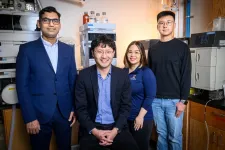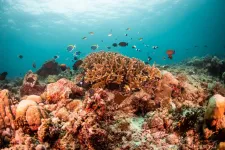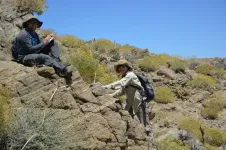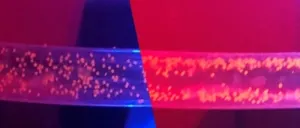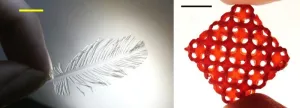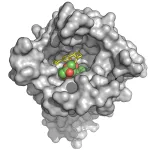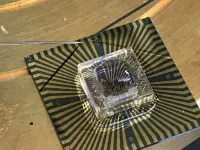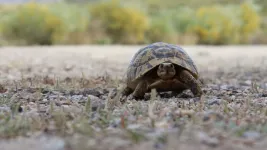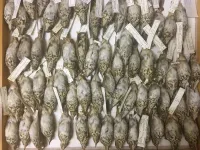(Press-News.org) CHAMPAIGN, Ill. — As new environmental regulations are rolling out to mitigate the industry-retired long-chain chemicals known as PFAS in drinking water, there are concerns regarding a new breed of “forever chemicals” called short-chain PFAS. Research from the University of Illinois Urbana-Champaign is helping shift the focus to include mitigation of the chemicals – which researchers say are just as persistent as, more mobile and harder to remove from the environment than their long-chain counterparts.
A study directed by chemical and biomolecular engineering professor Xiao Su uses electrosorption rather than filters and solvents and combines synthesis, separations testing and computer simulations to help design an electrode that can attract and capture a range of short-chain PFAS from environmental waters. The findings are published in the Journal of the American Chemical Society.
“One of the challenges of working with short-chain PFAS is that they are not well-studied. We know that they contain fewer carbon and fluorine atoms, making them shorter molecules and, therefore, more mobile – or freer to interact within the natural environment,” said Su, who collaborated with chemical and biomolecular engineering professor Diwakar Shukla. “Their electrostatic properties differ and they are more hydrophilic, meaning they are more apt to bond with water molecules. These properties combined make them more difficult to separate from water than their long-chained counterparts.”
The differences among short- and long-chain PFAS – and between long-chain PFAS in general – are significant enough for Su’s team to rethink its previously-developed electrode designed to attract, capture and destroy long-chain PFAS from the environment and drinking water sources. PFAS is an abbreviation for perfluoroalkyl and polyfluoroalkyl substances.
“One way to think of the behavior of short-chain PFAS is that they don’t like to be around anything except their own kind,” Su said. “So, to attract them, we need to sort of bait them with grafted fluorine groups – the ‘F’ in PFAS – on the surface of an electrode.”
Kinship is not the only challenge, though, Su said.
“The lengths of short-chain PFAS molecules vary, giving them different physical properties,” Su said. “This means we need to be able to tune the electrode just right to attract and eventually release the short-chain PFAS , with molecular-level understanding of the interactions being key to success.”
The study details the careful selection, matching and triangulating of different copolymer materials to develop an electrode that can attract a range of short-chain PFAS and induce an electric field to help release the molecules when needed.
Su said this work is a critical early step in removing short-chain PFAS from the environment, which have replaced long-chain PFAS in many industries.
“We still have much work to do,” Su said. “Future studies will focus on coupling the electrodes developed in this study with electrochemical degradation methods to ensure removal of these persistent contaminants from the environment.”
Illinois researchers Anaira Román Santiago, Jiho Lee and Johannes Elbert led the experimental investigations within the work, with graduate student Song Yin and Shukla leading the computational simulations.
The 3M Company, the National Science Foundation, the C3.ai Digital Transformation Institute and the National Center for Supercomputing at Illinois supported this study.
Su is affiliated with the Beckman Institute for Advanced Science and Technology and also is a professor of civil and environmental engineering at Illinois.
Editor’s notes:
To reach Xiao Su, call 217-300-0134; email x2su@illinois.edu.
The paper “Imparting selective fluorophilic interactions in redox copolymers for the electrochemically mediated capture of short-chain perfluoroalkyl substances” is available online. DOI: 10.1021/jacs.2c10963
END
SAN FRANCISCO, CA (March 28, 2023) — In a paper published today in the journal Environmental Research Letters, an international research team composed of scientists affiliated with more than a dozen institutions, including the California Academy of Sciences, propose a first-of-its-kind framework for governments around the world to evaluate their preparedness for—and guide future policies to address—ocean acidification, among the most dire threats to marine ecosystems.
“Ocean acidification is one of climate change’s silent killers,” says Rebecca Albright, PhD, Academy Curator of Invertebrate Zoology and ...
In North America’s hottest, driest desert, climate change is causing the decline of plants once thought nearly immortal and replacing them with shorter shrubs that can take advantage of sporadic rainfall and warmer temperatures.
Many studies have documented how a hotter, drier world is causing a redistribution of plants in temperate mountain regions. A new UC Riverside study documents the unexpected ways plants in part of the Sonoran Desert are doing the same.
“The plants ...
INDIANAPOLIS, March 28, 2023 — Colorful particles of plastic drift along under the surface of most waterways, from headwater streams to the Arctic Ocean. These barely visible microplastics — less than 5 mm wide — are potentially harmful to aquatic animals and plants, as well as humans. So, researchers are devising ways to remove them and to stop them at their source. Today, a team reports a two-stage device made with steel tubes and pulsing sound waves that removes most of the plastic particles from real water samples.
The researchers will present ...
INDIANAPOLIS, March 28, 2023 — The ancient art of origami is well known for transforming sheets of paper and other foldable materials into complex 3D shapes. But now, chemical engineers have extended the centuries-old practice to produce intricate shapes made of glass or other hard materials. Their thoroughly modern method, which can be combined with 3D printing, could have applications ranging from sculpture to catalysis and beyond.
The researchers will present their results today at the spring meeting of the American Chemical Society (ACS). ACS Spring 2023 is a hybrid meeting being held virtually and in-person ...
INDIANAPOLIS, March 28, 2023 — There’s been a recent push in the U.S. to make naloxone — a fast-acting opioid antidote — available without a prescription. This medication has saved lives, but it’s less effective against powerful synthetic opioids, such as fentanyl. In an interesting twist, researchers are now looking to cannabidiol (CBD), a component of marijuana, as a possible alternative to the popular antidote. Today, a team reports compounds based on CBD that reduce fentanyl binding and boost the effects of naloxone.
The researchers will present their results at the spring meeting of the American Chemical Society (ACS). ...
INDIANAPOLIS, March 28, 2023 — Have a cough, sore throat and congestion? Any number of respiratory viruses could be responsible. Conventional tests can identify certain likely culprits by relying on chemical reactions, but some researchers want to swap chemistry for electrical changes sensed by nanomaterials. Today, scientists report using a single-atom-thick nanomaterial to build a device that can simultaneously detect the presence of the viruses that cause COVID-19 and the flu — at much lower levels and much more quickly than conventional tests for either.
The researchers will present their results at the spring meeting ...
Research Highlights:
Weight loss was associated with decreased risk factors for cardiovascular disease and Type 2 diabetes for at least five years — even if some weight was regained, according to a review of research on behavioral weight loss programs.
People who lost weight through an intensive behavioral weight loss program had lower systolic blood pressure levels, total cholesterol-to-good cholesterol ratio and HbA1c levels (a diabetes marker), when compared to people who did not participate in a program or participated in a lower-intensity behavioral program.
Embargoed ...
New research led by the University of Oxford has revealed that the most endangered turtle and crocodile species are those that are most unique. Their loss could have widespread impacts on the ecosystems they live in, since they carry out critical processes important for many other species.
Turtles and crocodiles are two of the world's most endangered animal groups, with approximately half of species globally threatened (International Union for Conservation of Nature, IUCN). Greater understanding on which species are most threatened and why is urgently needed to inform conservation efforts to save them.
In a new study led by researchers at the Department of Biology, ...
Every year, millions of birds crash into windows in cities along their migratory path. For decades, scientists and volunteers have risen at dawn in spring and fall to collect the fallen birds, rehabilitating the injured and documenting the dead. The bodies of the birds killed in these collisions are a treasure trove of scientific information, especially when compared year after year. A new study in the journal Molecular Ecology makes use of these specimens to help understand the relationship between birds and the microbes living in their guts—which appears ...
Understanding of and trust in science and scientists are dangerously low, and initial studies suggest that a general lack of interest in science is even more of a problem than skepticism in Austria. A key partner in alleviating this mistrust, clearing up misunderstandings, and building up enthusiasm for science must be the media in general and science journalists in particular. However, these journalists need access to the information as well as the resources to work independently and give full flight to their curiosity and creativity. To work towards these goals and promote excellent science journalism, ISTA initiated a program to host journalists for two-to-four-month ...
